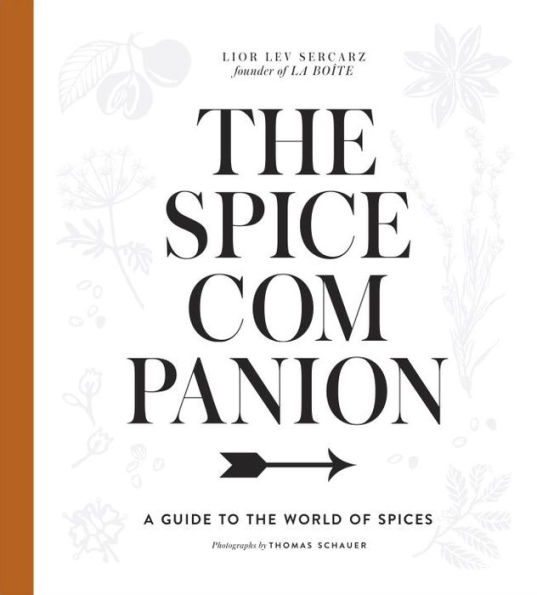The Spice Companion: A Guide to the World of Spices: A Cookbook
A stunning and definitive spice guide by the country’s most sought-after expert, with hundreds of fresh ideas and tips for using pantry spices, 102 never-before-published recipes for spice blends, gorgeous photography, and breathtaking botanical illustrations.
Since founding his spice shop in 2006, Lior Lev Sercarz has become the go-to source for fresh and unusual spices as well as small-batch custom blends for renowned chefs around the world. The Spice Companion communicates his expertise in a way that will change how readers cook, inspiring them to try bold new flavor combinations and make custom spice blends. For each of the 102 curated spices, Lev Sercarz provides the history and origin, information on where to buy and how to store it, five traditional cuisine pairings, three quick suggestions for use (such as adding cardamom to flavor chicken broth), and a unique spice blend recipe to highlight it in the kitchen. Sumptuous photography and botanical illustrations of each spice make this must-have resource—which also features debossing on the front cover, an orange-stained book edge, and a silver ribbon marker—as beautiful as it is informative.
"1137597472"
Since founding his spice shop in 2006, Lior Lev Sercarz has become the go-to source for fresh and unusual spices as well as small-batch custom blends for renowned chefs around the world. The Spice Companion communicates his expertise in a way that will change how readers cook, inspiring them to try bold new flavor combinations and make custom spice blends. For each of the 102 curated spices, Lev Sercarz provides the history and origin, information on where to buy and how to store it, five traditional cuisine pairings, three quick suggestions for use (such as adding cardamom to flavor chicken broth), and a unique spice blend recipe to highlight it in the kitchen. Sumptuous photography and botanical illustrations of each spice make this must-have resource—which also features debossing on the front cover, an orange-stained book edge, and a silver ribbon marker—as beautiful as it is informative.
The Spice Companion: A Guide to the World of Spices: A Cookbook
A stunning and definitive spice guide by the country’s most sought-after expert, with hundreds of fresh ideas and tips for using pantry spices, 102 never-before-published recipes for spice blends, gorgeous photography, and breathtaking botanical illustrations.
Since founding his spice shop in 2006, Lior Lev Sercarz has become the go-to source for fresh and unusual spices as well as small-batch custom blends for renowned chefs around the world. The Spice Companion communicates his expertise in a way that will change how readers cook, inspiring them to try bold new flavor combinations and make custom spice blends. For each of the 102 curated spices, Lev Sercarz provides the history and origin, information on where to buy and how to store it, five traditional cuisine pairings, three quick suggestions for use (such as adding cardamom to flavor chicken broth), and a unique spice blend recipe to highlight it in the kitchen. Sumptuous photography and botanical illustrations of each spice make this must-have resource—which also features debossing on the front cover, an orange-stained book edge, and a silver ribbon marker—as beautiful as it is informative.
Since founding his spice shop in 2006, Lior Lev Sercarz has become the go-to source for fresh and unusual spices as well as small-batch custom blends for renowned chefs around the world. The Spice Companion communicates his expertise in a way that will change how readers cook, inspiring them to try bold new flavor combinations and make custom spice blends. For each of the 102 curated spices, Lev Sercarz provides the history and origin, information on where to buy and how to store it, five traditional cuisine pairings, three quick suggestions for use (such as adding cardamom to flavor chicken broth), and a unique spice blend recipe to highlight it in the kitchen. Sumptuous photography and botanical illustrations of each spice make this must-have resource—which also features debossing on the front cover, an orange-stained book edge, and a silver ribbon marker—as beautiful as it is informative.
45.0
In Stock
5
1

The Spice Companion: A Guide to the World of Spices: A Cookbook
304
The Spice Companion: A Guide to the World of Spices: A Cookbook
304
45.0
In Stock

Product Details
| ISBN-13: | 9781101905463 |
|---|---|
| Publisher: | Clarkson Potter/Ten Speed |
| Publication date: | 11/01/2016 |
| Pages: | 304 |
| Sales rank: | 1,025,054 |
| Product dimensions: | 9.20(w) x 10.20(h) x 1.20(d) |
About the Author
From the B&N Reads Blog
